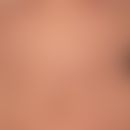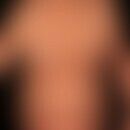Synonym(s)
HistoryThis section has been translated automatically.
DefinitionThis section has been translated automatically.
You might also be interested in
EtiopathogenesisThis section has been translated automatically.
Translocations of the CREBBP gene (gene locus: 16p13.3) with consecutive disruption of the "CREB binding protein".
ClinicThis section has been translated automatically.
Mental retardation, growth retardation, antimongoloid palpebral fold, hypertelorism, high gothic palate, dental anomalies, deformities of nose and ears. Shortening and plumping of finger and toe phalanges. In addition, in more than 50% of cases, there is a nevus teleangiectaticus of the forehead or neck and hypertrichosis of the back. Pilomatrixomas have been described in association.
Of note, several studies have demonstrated an increased keloid tendency for Rubinstein-Taybi syndrome (Jfri A et al 2018). Keloids occur in 24% of individuals with RSTS, either spontaneously or after minor trauma, usually beginning in early puberty (van de Kar AL et al. 2014). Most patients had multiple keloids. The mean age of onset was 11-9 years. The majority of keloids were located on the shoulders and chest (van de Kar AL et al. 2014).
Differential diagnosisThis section has been translated automatically.
LiteratureThis section has been translated automatically.
- Bozkirli F et al (2000) Anesthetic management of a child with Rubinstein-Taybi syndrome for cervical dermoid cyst excision. J Anesth 14: 214-215
- Jfri A et al (2018) Spontaneous keloids: a literature review. Dermatology 234:127-130.
- Rubinstein JH, Taybi H (1963) Broad thumbs and toes and facial abnormalities. Am J Dis Child 105: 588-608.
- van de Kar AL et al (2014) Keloids in Rubinstein-Taybi syndrome: a clinical study. Br J Dermatol 171:615-621.
Incoming links (5)
Broad thumb-hallux syndrome; Broad thumb-mental syndrome; CREBBP Gene; Pilomatrixoma; Rubinstein syndrome;Outgoing links (7)
Cornelia de lange syndrome; CREBBP Gene; Hypertelorism; Hypertrichoses; Keloid (overview); Pilomatrixoma; Teleangiectatic nevus;Disclaimer
Please ask your physician for a reliable diagnosis. This website is only meant as a reference.




